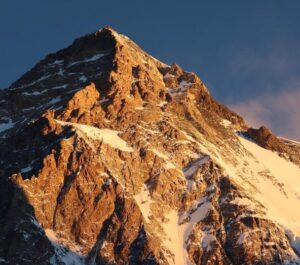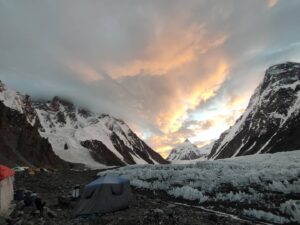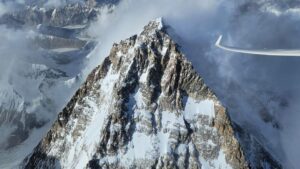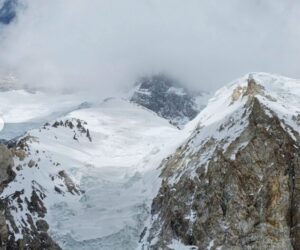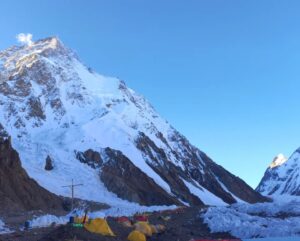With today’s chapter, we end our series on the Second Seven Summits. The lesser-known and more difficult little brother of the Seven Summits involves climbing the second-highest peak on each continent.
It inspired us to present these seven peaks, their first explorations and ascents, the cast of characters who stepped on their slopes, their geographical characteristics, and everything remarkable related to mountaineering in these beautiful mountains.
A look back
The history of each of these mountains is very different. On K2, we recounted routes that were never repeated and names that should not be forgotten. The little-known Mount Townsend in Australia has a history awash with cartographic confusion. Mount Logan features the dangerous Hummingbird Ridge. On Mount Kenya, we explored the incredible story of Italian prisoners who escaped to climb the mountain.
We followed in Mummery’s footsteps on Dykh-Tau in the Caucasus and we investigated the curiosities of the highest volcano in the world, Nevado Ojos del Salado in South America.
Finally, we discovered the beauty of distant Mount Tyree, with its 2,000m+ south face that remains unclimbed.

People we should not forget.
The origin of an idea, Dick Bass and his challenge
Indirectly, the idea of the Second Seven Summits comes from Dick Bass. Richard Daniel “Dick” Bass (1929-2015) was an American businessman and mountaineer. A geology graduate from Yale University, he served for two years in the US Navy, and later owned a ski resort in Utah, USA.
Together with Frank Wells, former president of the Walt Disney Company, Bass decided to climb the highest mountain on each continent. From the Seven Summits, the Second Seven Summits would eventually spring.
Bass and Wells climbed almost all the highest peaks on each continent: Denali (North America), Aconcagua (South America), Elbrus (Europe), Kilimanjaro (Africa), Vinson (Antarctica), and Kosciuszko (Australia). However, Everest (Asia) proved more difficult.

Dick Bass. Photo: The New York Times
The last goal, Everest
Having turned back on Everest twice, Bass made a third attempt, this time with David Breashears and Nepalese climber Ang Phurba Sherpa. They managed to summit Everest on April 30, 1985.
All three climbers used supplemental oxygen during the climb. Ang Phurba was 23, Breashears 29, and Bass was near twice their age, 55. Bass became the oldest person to climb the world’s tallest mountain. The previous age record was held by Chris Bonington, who had climbed Everest a few days earlier, on April 21, 1985, also using bottled oxygen. Bonington was then 50 years old.
Bass became the first person to climb all Seven Summits.

Dick Bass on the summit of Everest. Photo: Dick Bass
Little recognition from hardcore mountaineers
Bass was not recognized as a particularly good mountaineer by the mountaineers of his time, however, he was a very strong man. It should be noted that during his ascent of Everest, he climbed the summit ridge with no fixed rope and on 2L/min oxygen flow. Clients on modern commercial expeditions tend to use 8L/min oxygen flow on fixed ropes and have two or three Sherpas who carry the oxygen bottles.
In some ways, Bass can be seen as a forerunner of commercial expeditions. He showed that mountaineering does not have to be that hard, provided you have the money and logistics set up.

Reinhold Messner. Photo: Reinhold Messner
The Messner list vs the Bass list
There are differences of opinion when determining the concept of continents, and there have been debates about the exact heights of many mountains. For this reason, there is more than one Seven Summits list.
One list is named after Reinhold Messner, who was also in the running to be the first to complete the Seven Summits. The Messner list, also called the Carstensz list, differs from the Bass list over Australiasa. Mount Kosciuszko verses Puncak Jaya is a tricky debate.
Messner thinks that in Australasia, the highest mountain is Puncak Jaya, also called Carstensz Pyramid (4,884m) in Indonesia. In this interpretation, Australasia includes Australia, New Zealand, New Guinea, and some neighboring islands in the Pacific.
As we have detailed before, the debate comes down to whether you are looking to climb the highest peak on the Australian mainland or the Australian continent. Complications arise when you look at political boundaries. Puncak Jaya lies in Papua, Western New Guinea, and is part of Indonesia. Indonesia is in Asia. However, sticking with geographical rather than political boundaries puts Puncak Jaya on the same continental shelf as Australia.

Puncak Mandala, aka Juliana Peak in Papua, Indonesia. Photo: Christian Stangl
For the Second Seven Summits, according to Messner’s list, the second-highest peak in Australiasia would therefore not be Mount Townsend, but Puncak Mandala, also called Juliana Peak (4,760m), in Papua, Indonesia.
The list debate hasn’t been categorically settled.
Greg Child and the “last great challenge”
In 1998, Australian mountaineer and writer Greg Child, known for his good humor and storytelling, published his book Postcards From the Ledge. He wrote that climbing Everest “may not be the zenith of climbing”. Tongue firmly in cheek, he wrote that it would be interesting if there was an objective that gave meaning to ascents and came up with the LGC (Last Great Challenge).

“Somewhere between the bottom of the climb and the summit is the answer to the mystery of why we climb.” Greg Child. Photo: Greg Child
Child laid out the guidelines to make the challenge famous: “Get a publicist or an agent to groom your image as a suitable representative of a master race of thrill-seekers. Your publicist will then alert the media. With remorseless repetition, you must hammer out the message that your mission is the Mother of All Last Great Challenges.”
His suggestion for the LGC? “I challenge all comers to a race for the Seven Second-highest Summits. But wait, I hear my fax machine spitting out a message. Perhaps is my publicist. Maybe a big corporate sponsor wants to invest in my challenge to be second best. Ladies and gentlemen, start your engines and count up your frequent flyer thousands. The race for the LGC has begun!”
What Child humorously described in his book, mirrors a lot of what we see today. “Portray yourself and your climbing team as icons of human endeavor. It helps to be good-looking, after all, this is a beauty contest,” Child wrote.
Climbing the Second Seven Summits
They may be “second” but, as a whole, the Second Seven Summits are more difficult to climb than the Seven Summits, with the clear exception of Mount Townsend from the Bass list.
After several failed attempts, New Zealand mountaineer Rob Hall finally summited K2 in 1994. Hall intended to go on to complete the Second Seven Summits but died in the May 1996 Everest tragedy.
After Hall, a wave of climbers was encouraged by the challenge of the Second Seven Summits. Among them, Canadian Arno Botha, Indian Satya Dam, Brit Sean James, Italian Hans Kammerlander, and Austrian Christian Stangl.
However, there was no clear agreement as to which list to use. To avoid dispute, some climbers climbed all the candidate peaks.

Hans Kammerlander. Photo: Hans Kammerlander
Stangl and the K2 issue
In 2010, Christian Stangl claimed to have climbed K2. It was later discovered that Stangl used a false summit photo and had not climbed the mountain. He later admitted the false claim, which caused a big scandal in the alpine world.
However, we also have to take into account that Stangl, a great mountaineer despite his lie, did admit and publicly acknowledged his deception. Stangl finally returned to K2 and climbed it two years later, in 2012, without the use of supplemental oxygen.

Christian Stangl on the summit of Shkhara, Caucasus. Photo: Christian Stangl
Kammerlander and Mount Logan
After ascending Mount Tyree on January 3, 2012, Italian mountaineer Hans Kammerlander claimed to be the first to have climbed all the Second Seven Summits. Shortly after, the mountaineering community voiced their doubts. It seemed that Kammerlander had not reached the main summit of Mount Logan, but only the slightly lower west summit, due to confusion rather than deception.
Kammerlander later returned to Mount Logan to correct the error.

The glacial landscape encircling Mount Logan. Photo: Jerry Kobalenko
Who was first?
In 2013, Christian Stangl was the first person to climb all the Second Seven Summits and also became the first person to climb the third highest peaks of each continent.
To avoid any dispute over measurement and definition issues, he scaled 30 peaks. In 2013, Guinness World Records certified his achievement.


